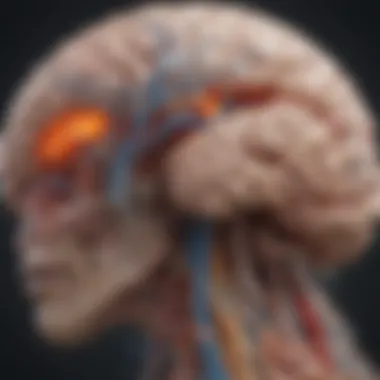Understanding Palsy and Hand Tremors: A Comprehensive Overview


Intro
Palsy and hand tremors represent a broad spectrum of neurological conditions that can significantly impact motor function and daily living. The repercussions of these disorders extend beyond simple physical limitations; they influence emotional well-being and social interactions. As such, understanding their definitions, causes, and treatment options has vast implications for both patients and healthcare providers.
The complexities of these conditions highlight the urgent need for continued research and development of innovative therapies. This article aims to dissect the multifaceted nature of palsy and hand tremors, revealing their intricate relationship with neurological health and functioning.
Research Overview
Summary of Key Findings
Research has revealed various factors contributing to palsy and hand tremors, including genetic predispositions, environmental triggers, and underlying health issues. Studies suggest a significant connection between these conditions and neurological disorders such as Parkinson's disease and cerebral palsy. Additionally, new findings point to the importance of early diagnosis, which can drastically improve outcomes and quality of life.
Background and Context
Palsy encompasses several conditions that impair muscle control and coordination, while hand tremors are often a symptom of underlying neurological issues. According to the World Health Organization, these disorders are increasingly recognized in global public health discussions. Understanding the historical and social contexts of these conditions can offer insights into their ongoing management and treatment options.
Methodology
Experimental Design
Research into palsy and hand tremors often employs longitudinal studies, allowing researchers to observe patients over extended time frames. This design enables the identification of patterns and the effects of interventions on motor function.
Data Collection Techniques
Data collection varies from clinical assessments that evaluate motor skills to patient-reported outcomes. The integration of advanced imaging techniques and neurophysiological assessments enhances the understanding of how neurological disorders manifest in physical symptoms. Researchers also utilize surveys and interviews to gather qualitative data, enriching the overall findings.
While the prevalence of palsy and hand tremors is well-documented, many affected individuals experience varied symptoms and challenges that reflect the complexity of their conditions.
Through the examination of existing literature and emerging studies, this article will delve further into the implications of these conditions, the potential treatment pathways available, and the ongoing research that seeks to improve management strategies.
Prelude to Palsy and Hand Tremors
The discussion surrounding palsy and hand tremors is crucial for understanding various neurological conditions and their impact on individuals’ lives. This section serves as a foundation for the article, providing context about these complicated disorders. It highlights the importance of comprehensive knowledge about palsy and hand tremors, covering definitions, potential causes, and implications for daily living. By delving into these areas, we can appreciate the challenges faced by those affected and the importance of effective management.
Defining Palsy
Palsy refers to a range of medical conditions characterized primarily by muscle weakness or paralysis. While it is commonly associated with conditions that affect the ability to control bodily movements, the term encompasses various types that may differ in their causes and symptoms. A key point is that palsy is not a single disorder; rather, it is an umbrella term that includes conditions such as cerebral palsy, Bell's palsy, and Erb's palsy. These variations arise from different neurological origins and may manifest in distinct ways. For instance, cerebral palsy originates from brain injury during or shortly after birth, affecting motor skills and coordination. In contrast, Bell's palsy is a temporary facial paralysis often related to viral infections.
Understanding these definitions helps in identifying the underlying causes and potential treatments. It is also important for educators, healthcare providers, and families to grasp these distinctions in order to provide adequate support and resources for those affected.
Understanding Hand Tremors
Hand tremors, on the other hand, involve involuntary rhythmic shaking, primarily in the hands and arms. They can result from various underlying issues, such as neurological disorders, medication side effects, or metabolic conditions. Tremors can significantly impact a person's ability to perform daily tasks, affecting their quality of life.
There are different types of hand tremors. They can be classified based on when they occur—either while at rest or during purposeful movement. Understanding these distinctions can aid in diagnosis and treatment.
It is important to acknowledge that the implications of tremors go beyond physical limitations. They can also influence emotional well-being, leading to increased anxiety or frustration for individuals.
Types of Palsy
Understanding the different types of palsy is crucial for appropriate diagnosis and treatment. Each type presents unique characteristics, underlying causes, and implications for patients. Recognizing the distinctions among these types can help tailor therapeutic approaches and management strategies effectively. Furthermore, knowledge about these forms of palsy assists in informing patients and their families about the nature and course of the condition. This section aims to elucidate the significant types of palsy and provide insights into their clinical manifestations, potential outcomes, and considerations for care.
Cerebral Palsy
Cerebral palsy is a neurological disorder that stems from early brain injury, affecting movement and coordination. It is characterized by symptoms that vary widely among individuals, depending on the parts of the brain that are impacted. Motor difficulties in cerebral palsy may include stiffness, weakness, or uncontrolled movements.
- Key Characteristics:
- Muscle tone abnormalities, including rigidity or spasticity.
- Challenges with balance and posture.
- Difficulty with fine motor skills.
The causes of cerebral palsy can include oxygen deprivation during birth, infections during pregnancy, or genetic factors leading to abnormal brain development. Early intervention is vital, as therapies such as physical and occupational therapy can significantly improve functional capabilities.
"Cerebral palsy affects approximately 1 in 345 children, making it the most common motor disability in childhood."
Bell's Palsy
Bell's palsy results from inflammation of the facial nerve, leading to sudden weakness or paralysis on one side of the face. The exact cause of Bell's palsy is often unclear, but it is believed to be linked to viral infections, particularly those affecting the respiratory system. Symptoms typically appear quickly, often overnight and may include:
- Facial Droop: Affected individuals may have difficulty closing the eye or smiling on one side.
- Altered Taste: Changes in the ability to taste may also be present.
- Ear Pain: Some experience discomfort around or inside the ear.
While the condition can be alarming, the good news is that most people experience a full recovery within a few weeks to months, often without treatment. Corticosteroids may speed up the recovery process by reducing inflammation of the facial nerve.
Erb's Palsy
Erb's palsy, also known as brachial plexus paralysis, occurs when there is damage to the brachial plexus nerves, which control the muscles of the arm and hand. This type of palsy often happens during delivery, especially with complicated births that involve shoulder dystocia. Symptoms may manifest as weakness or paralysis of one arm, making daily tasks challenging.
- Main Symptoms:
- Inability to move the affected arm normally.
- Arm hangs in a particular position, often turned inward.
- Lack of grip strength in the hand.
Treatment typically involves physical therapy to promote muscle strength and coordination. In some cases, surgical intervention may be necessary to repair nerve damage or improve function.
Understanding these types of palsy enhances the comprehensiveness of a treatment plan and improves outcomes for affected individuals. Awareness fosters a supportive environment for patients and their families, guiding them through what can be a challenging journey.


Types of Hand Tremors
Understanding the various types of hand tremors is crucial for a comprehensive grasp of how these involuntary movements can impact individuals. Each type has distinct characteristics, causes, and implications that influence the management strategies and treatment options available. This section aims to clarify these categories for individuals affected by tremors, their families, and healthcare professionals. By distinguishing between types of hand tremors, it becomes easier to approach diagnosis and tailor treatment to specific needs.
Resting Tremors
Resting tremors are typically observed when a person is at rest. This type of tremor commonly occurs in conditions like Parkinson's disease. It manifests as a rhythmic shaking that often affects the hands, though it may involve other body parts, such as the jaw or legs.
The unique aspect of resting tremors is that they tend to diminish when the individual moves. This characteristic can provide valuable diagnostic information for health practitioners. In some cases, these tremors can be exacerbated by stress or fatigue, making it essential to consider psychological elements in management.
Resting tremors serve as an indicator of underlying neurological conditions and hence warrant thorough clinical evaluation.
Action Tremors
Action tremors arise during voluntary movements. This type includes postural tremors, which occur when the limbs are maintained in a position against gravity, and kinetic tremors, which are present during purposeful movements such as reaching for an object.
Conditions like essential tremor often present with action tremors, which can significantly impair the ability to perform daily tasks. The tremors may vary in intensity and frequency, affecting not only fine motor skills but also gross motor abilities. Identifying the specific pattern of action tremors can help doctors provide more targeted treatment options.
Chronic Tremors
Chronic tremors are those that persist over an extended period. These tremors can evolve from another condition or arise independently. They often indicate a persistent neurological condition that requires ongoing management.
Patients may experience both resting and action tremors as part of a chronic condition, such as multiple sclerosis or severe essential tremor. Because chronic tremors can interfere greatly with daily life—impacting work, social interactions, and emotional health—understanding the factors that contribute to chronicity is crucial for effective treatment planning and psychological support.
In summary, recognizing the types of hand tremors not only aids in proper diagnosis but also helps inform treatment paths, enabling affected individuals to navigate their experiences more effectively.
Causes of Palsy
Understanding the causes of palsy is crucial in grasping how these conditions manifest and affect individuals. Identifying the factors that contribute to palsy can facilitate early detection, intervention, and management. Knowledge of these elements can also guide future research for more effective treatments. Factors leading to palsy can be classified into genetic, environmental, and prenatal categories, each offering valuable insights into this complex condition.
Genetic Factors
Genetic factors play a significant role in the occurrence of certain types of palsy. Specific genetic mutations or inherited traits can lead to conditions like cerebral palsy, which often arises from disruptions in the development of the brain. Research indicates that individuals with a family history of neurological disorders may be at a higher risk.
Some genes associated with the development of the nervous system have been studied for their links to palsy. For example, mutations in the genes related to neuronal growth may influence motor function. Understanding these genetic underpinnings helps medical professionals in assessing risk factors and creating tailored treatment plans.
Environmental Influences
Environmental factors can also significantly contribute to the risk of developing palsy. Situations such as exposure to toxins or infections during pregnancy can lead to issues in fetal brain development. For instance, a mother exposed to certain chemicals or infectious diseases like rubella may increase the risk of her child developing cerebral palsy.
Moreover, factors such as low birth weight, premature birth, and complications during labor can impact the likelihood of palsy. Each environmental condition contributes cumulatively, highlighting the importance of awareness and preventive care.
Prenatal Factors
Prenatal factors encompass aspects related to the health and wellness of the mother during pregnancy. Maternal health conditions such as diabetes or high blood pressure can adversely affect fetal development. If these conditions are not managed properly, they may lead to compromised brain health in the developing child.
Additionally, nutritional status during pregnancy is vital. Deficiencies in essential nutrients, such as folic acid, can lead to neural tube defects that might ultimately contribute to palsy. Prenatal medical care that includes proper screening and nutrition can significantly reduce risks associated with palsy.
It is imperative to consider that the interaction of genetic, environmental, and prenatal factors can vary greatly among individuals, making each case of palsy unique.
Causes of Hand Tremors
Understanding the causes of hand tremors is crucial for both diagnosis and treatment. This section elucidates several factors that contribute to tremors, allowing for a nuanced perspective on their origins. Grasping these causes enhances the ability to tailor appropriate intervention strategies. Recognizing the underlying issues helps in managing symptoms effectively and reducing their impact on daily life.
Neurological Disorders
Hand tremors frequently stem from neurological disorders. Parkinson's disease is one of the most recognized causes. It affects the brain areas that control movement. People with this disorder often exhibit resting tremors, primarily distinguished by their occurrence when the hand is still. Multiple sclerosis can also cause tremors, as it disrupts communication between the brain and the body. This leads to a lack of coordination and shaking that may manifest in the hands. Traditional neurological assessments are pivotal to identify these conditions accurately.
Other disorders, such as essential tremor, are less understood but prevalent. Essential tremor is often hereditary and manifests during voluntary movements. The underlying mechanisms remain unclear, but it’s important to investigate genetic predispositions when diagnosing. Furthermore, conditions like dystonia affect muscle contractions and can lead to hand tremors through continuous muscle spasms.
Medication Side Effects
Medications can lead to tremors as an unintended side effect. Drugs used for several conditions, including psychiatric disorders, can significantly influence muscle control and coordination. For instance, medications like lithium, used for bipolar disorder, may induce tremors. Similarly, some asthma medications, particularly beta-agonists, can also result in shaky hands.
Understanding the connection between medications and tremors necessitates careful evaluation. Physicians must consider the benefits of prescribed drugs against potential side effects, including tremors. Regular monitoring and possible adjustments of the treatment strategy can mitigate these unwanted effects. Furthermore, informing patients about these risks empowers them to communicate more openly with their healthcare providers.
Metabolic Conditions
Certain metabolic conditions can contribute to hand tremors as well. Hyperthyroidism is a prominent example, where excessive thyroid hormones accelerate metabolism, potentially causing shaky hands. Patients often experience tremors alongside other symptoms like rapid heartbeat and weight loss. Diagnosis typically involves blood tests to measure hormone levels, providing a clearer picture for treatment.
Other metabolic disorders, like low blood sugar (hypoglycemia), can also induce tremors. When blood sugar drops, the body responds with adrenaline release, efectively causing shaking as a physiological response. Quick corrective measures, like glucose intake, often resolve these symptoms.
In strategy for managing hand tremors, identifying any metabolic conditions remains essential. Addressing such underlying issues can lead to significant improvements in symptom control and overall well-being.
"Recognizing the causes of hand tremors is as important as identifying the symptoms, as it informs the pathway to effective treatment."
Understanding the multifaceted causes of hand tremors can greatly improve management strategies. Each factor plays a role in shaping an individual's experience with tremors, highlighting the need for personalized approaches in treatment.
The Neurological Mechanisms Behind Palsy and Tremors
Understanding the neurological mechanisms behind palsy and hand tremors is crucial. It helps delineate how these conditions manifest, how they affect motor control, and the potential avenues for treatment. The brain and nervous system play profound roles in governing movement and coordination. When these systems are compromised, as seen in various types of palsy and tremors, it significantly impacts one's quality of life. By identifying the specific neurological deficits, healthcare providers can develop more targeted intervention strategies.
Impact on Neural Pathways
Neural pathways are essential for transmitting signals between the brain and the body. In conditions like palsy and hand tremors, these pathways may be disrupted. Damage or abnormalities in these pathways can lead to impaired motor functions. For instance, in cerebral palsy, the brain fails to send correct signals to muscles due to early brain lesions, resulting in spasticity or muscle weakness. Likewise, in hand tremors, aberrant signaling might cause unintentional movements, hindering fine motor skills.


The impact on neural pathways manifests differently across individuals. Factors such as the type of palsy, severity, and age of onset all contribute to the specific symptoms experienced.
"Understanding how neural pathways are affected offers a better grasp of the challenges faced by those with these conditions."
Healthcare professionals rely on the knowledge of these pathways to inform diagnosis and treatment. Effective rehabilitation may focus on re-establishing these pathways, thereby improving motor function and reducing tremors.
The Role of the Basal Ganglia
The basal ganglia are a group of nuclei in the brain that are integral to movement regulation. They play a significant role in smoothening and coordinating voluntary movements. Dysfunction in the basal ganglia can lead to tremors, especially when there is an imbalance in neurotransmitter activity.
In people with conditions like Parkinson's disease, a lack of dopamine in the basal ganglia is particularly noteworthy. This deficiency is closely correlated with the presence of resting tremors seen in patients. Essentially, when signaling processes within the basal ganglia become impaired, it can result in unwanted motor activity, including tremors.
The understanding of the basal ganglia's role can assist researchers and clinicians in formulating new therapeutic approaches. For example, targeting neurotransmitter pathways in the basal ganglia could offer promising treatment avenues for reducing tremors. This focus highlights the significance of the basal ganglia in both the perception and treatment of motor disturbances, making it a vital area of ongoing research.
Diagnosis of Palsy and Hand Tremors
Diagnosis plays a critical role in managing palsy and hand tremors. Accurate identification of these conditions can set the stage for effective treatment plans, significantly improving the quality of life for those affected. Early diagnosis can help in planning interventions and aids to enhance daily functionality. Considering the variety of causes underlying these conditions, a comprehensive diagnostic approach is essential. This section delves into the key components involved in diagnosing palsy and hand tremors, categorizing them into clinical evaluations and diagnostic imaging techniques.
Clinical Evaluation
A clinical evaluation is often the first step in diagnosing palsy and hand tremors. It involves a thorough assessment conducted by a healthcare professional. During this evaluation, the doctor will gather detailed medical histories, focusing on any symptoms and their onset. This information is crucial in distinguishing between the types of palsy and the specific nature of hand tremors.
Key aspects of clinical evaluation:
- Medical History: Understanding any genetic or environmental factors that might contribute to the condition.
- Symptom Review: Careful observation of tremor types, muscle stiffness, and coordination issues that the patient experiences.
- Physical Examination: Testing strength, reflexes, and coordination to observe the impact on motor function.
- Neurological Assessment: Determines if there are underlying neurological issues.
A complete clinical evaluation not only aids diagnosis but also helps in identifying any comorbid conditions, which may influence treatment decisions and strategies to manage symptoms.
Diagnostic Imaging Techniques
In some cases, clinical evaluation alone may not provide a conclusive diagnosis. Here, diagnostic imaging techniques become essential. These methods allow for visualization of the brain and nervous system, offering insights into structural or functional abnormalities. Imaging can help distinguish between different types of palsy and tremors, directing the path for tailored treatment options.
Common imaging techniques include:
- MRI (Magnetic Resonance Imaging): This provides detailed images of brain structures, revealing any anomalies that may relate to palsy.
- CT (Computed Tomography) Scans: Used to observe structural abnormalities.
- PET Scans (Positron Emission Tomography): These can reveal changes in brain activity associated with tremors and palsy.
Diagnostic imaging is vital in confirming diagnoses and ruling out other neurological disorders, essential for effective treatment planning.
In summary, diagnosing palsy and hand tremors combines clinical evaluation and imaging techniques. Each step is essential in elucidating the complexity of these conditions, ensuring appropriate and timely management.
Treatment Options for Palsy
Treatment options for palsy are critical for improving the quality of life for those affected. These options can aim to enhance mobility, increase independence, and reduce discomfort associated with the condition. It is essential to carefully consider various elements in the treatment from the patient’s perspective, including how these strategies integrate into their daily lives and the support they can offer. Moreover, understanding the benefits and limitations of treatments helps in setting realistic goals for recovery and managing expectations.
Physical Therapy Approaches
Physical therapy plays a pivotal role in the management of palsy. The primary goal is to promote mobility and functional independence among patients. This therapy includes individualized exercise programs designed to strengthen muscles, improve coordination, and enhance overall motor skills. Often, exercises are tailored to the specific type of palsy the person is experiencing.
Benefits of physical therapy may be significant:
- Enhanced Mobility: Regular sessions help in maintaining or enhancing the range of motion.
- Strength Building: Physical therapists guide patients through strength training exercises to support weakened muscles.
- Functional Skills: Patients often practice daily activities with their therapist to improve their ability to perform them independently.
Physical therapists not only focus on the physical aspects but also on the emotional support. Encouragement and regular feedback can motivate patients to set and achieve personal goals. It is crucial for caregivers and family members to be involved in the process, as they can provide additional encouragement and assistance.
Surgical Interventions
In some instances, surgery may be necessary to treat certain types of palsy. Surgical interventions can address specific problems like muscle tightness or joint deformities. Procedures such as tendon lengthening or muscle transfers may restore function and improve alignment. While surgery is often considered when other treatments do not yield sufficient improvement, it is vital to weigh the potential benefits against risks like complications or recovery time.
Key considerations in surgical interventions include:
- Careful Evaluation: Thorough assessments by healthcare professionals determine if surgery is appropriate.
- Long-Term Planning: Surgery often requires a comprehensive rehabilitation plan post-operation to achieve optimal outcomes.
- Multidisciplinary Approach: Collaboration between surgeons, physical therapists, and occupational therapists ensures a holistic recovery process.
"Surgical options can significantly change a patient's life, offering them abilities they may not have had through non-surgical methods."
In summary, treatment options for palsy are essential for enhancing life quality for affected individuals. These treatments can range from non-invasive physical therapy to more intensive surgical procedures. Both methods require careful consideration and collaboration among healthcare providers, patience, and commitment from patients and their families.
Management of Hand Tremors
Hand tremors can greatly affect daily living, making simple tasks challenging. Their management is essential for improving quality of life. Individuals suffering from hand tremors may experience difficulties in writing, eating, or performing fine motor tasks. The management strategies for hand tremors fall into two primary categories: pharmacological treatments and lifestyle adjustments. Each approach addresses different aspects of the condition and contributes to the overall well-being of the individual.
Pharmacological Treatments
Pharmacological treatments involve the use of medications designed to mitigate the effects of tremors. Several drug classes are commonly explored, and their effectiveness can vary depending on the underlying cause of the tremors.
- Beta-blockers: These medications, such as propranolol, can be effective for essential tremors. They work by reducing the intensity of tremors, providing temporary relief.
- Anticonvulsants: Medications like primidone, typically used to treat seizures, have also shown effectiveness in managing tremors.
- Benzodiazepines: Drugs such as diazepam may provide relief in certain situations, particularly for tremors exacerbated by anxiety.
- Botox injections: Botulinum toxin can be used in targeted areas to reduce tremors, especially when they are localized.
Always consult with a healthcare professional before starting any medication. Different individuals may respond distinctly to treatments.
Monitoring the effectiveness and potential side effects of these pharmacological interventions is crucial. In some cases, a combination of medications may be necessary to achieve optimal management of tremors.
Lifestyle Adjustments
In addition to medications, lifestyle adjustments play a significant role in managing hand tremors. These modifications can directly influence the daily life of someone with tremors. Here are some effective strategies:
- Stress Management: Since stress and anxiety can exacerbate tremors, techniques such as meditation, deep breathing, or yoga can be helpful.
- Assistive Devices: Utilizing adaptive devices like weighted utensils or special grips can help individuals perform tasks more comfortably.
- Regular Exercise: Maintaining physical activity can improve overall motor control. Engaging in specific exercises designed to enhance coordination may also be beneficial.
- Dietary Considerations: Limiting caffeine and sugar can help reduce tremors, as these substances may exacerbate symptoms.
- Occupational Therapy: Working with a therapist can provide tailored strategies and techniques for improving function in daily living.


Making these lifestyle changes can significantly enhance the ability to manage hand tremors while improving overall quality of life. Each individual will need to assess which adjustments work best for their specific circumstances to maximize their effectiveness.
Psychosocial Impacts of Palsy and Tremors
Understanding the psychosocial impacts of palsy and hand tremors is essential in the broader discourse of neurological conditions. These effects extend beyond the physical symptoms, influencing emotional well-being and social integration. The people who live with these conditions often face significant challenges that affect their quality of life. It is critical to recognize these impacts to provide appropriate support, develop effective interventions, and foster inclusive environments.
Emotional Effects
The emotional ramifications of palsy and hand tremors can be profound. Individuals may experience feelings of frustration, anxiety, and depression stemming from their everyday struggles. This can include the inability to perform simple tasks such as writing or lifting objects, which can lead to a decrease in self-esteem. Many find that the constant effort to manage their symptoms affects their mental health, prompting a cycle of negative emotional responses.
Furthermore, the stigma associated with visible disabilities can also contribute to feelings of isolation. It is not uncommon for individuals to withdraw socially, fearing judgment or misunderstanding from others. Those dealing with palsy or tremors may require therapeutic assistance to navigate these emotional challenges effectively.
"Emotional support is as critical as physical therapy in managing disabilities like palsy and tremors."
Societal Perceptions
Societal perceptions greatly influence how individuals with palsy and hand tremors are viewed and treated. Often, there is a lack of awareness and understanding surrounding these conditions, which can lead to misconceptions. This affects not only the individuals who live with these disorders but also how they interact with the world around them.
For instance, many may see individuals with tremors as less capable, which undermines their potential and contribution. Such perceptions can lead to discrimination in various aspects of life, including employment and social activity. It is imperative that society progresses towards a more inclusive attitude, recognizing the abilities and rights of those with disabilities. Education and advocacy can play a crucial role in reshaping these perceptions.
Creating awareness about palsy and hand tremors can facilitate compassion and understanding, paving the way for a more accepting environment. This can also encourage individuals with these conditions to seek help and engage more fully in their communities, helping them to overcome emotional barriers.
Current Research Trends
Research trends in neurology often shape how conditions like palsy and hand tremors are understood and treated. This section examines the emerging themes in research that are crucial for improving both medical approaches and patient quality of life.
Neurological Advances
Neurological advances focus on unraveling the complexities of the brain and its functions. In the context of palsy and hand tremors, researchers are studying neural pathways and how they can be modified. One significant advance is in neuroplasticity. This is the brain’s ability to reorganize itself by forming new neural connections throughout life. Understanding how neuroplasticity works could lead to better rehabilitation techniques for individuals with movement disorders.
Research indicates that targeted therapies can encourage neuroplasticity. This offers hope in recovering lost motor functions or improving overall independence. Increasingly, scientists are investigating the role of non-invasive brain stimulation techniques. These techniques can modify brain activity, which might be beneficial for reducing tremors or spasticity in palsy patients.
Advances in understanding brain functions can drastically improve treatment outcomes for palsy and tremors.
Therapeutic Innovations
Therapeutic innovations represent the practical applications of research findings. They include new treatments and rehabilitation strategies that emerge from the latest neurological insights. One area of focus is the development of personalized treatment plans that cater to the specific needs of each patient. This may involve the use of advanced imaging techniques to assess individual brain activity and responses to therapy.
Another promising innovation is the exploration of gene therapy. For certain types of palsy, researchers are looking into methods that might correct the genetic factors contributing to motor dysfunction. This can open doors to treatments that are more effective and targeted.
Moreover, advances in wearable technology are also making a mark. Devices that track movement and provide real-time data can help adjust therapy programs for individuals. This feedback loop allows for continuous improvement in managing symptoms.
Future Directions in Treatment and Research
The field of therapy and research for palsy and hand tremors is ever-evolving. Emphasizing future directions is key for several reasons. It allows for understanding how emerging treatments can improve quality of life. It also helps identify areas where further research needs to be conducted.
As new therapies develop, they may provide enhanced options for individuals facing these challenges. Ongoing research is not just about creating new drugs. It often involves novel approaches to physical therapy and rehabilitative training. Ensuring that these new methodologies have support from clinical studies adds credibility. This can impact funding and attention in both public and private sectors.
In essence, this section attempts to outline specific advancements that could redefine treatment landscapes. The benefits might lead to better management of symptoms, reducing the burden on patients and caregivers alike.
Emerging Therapies
Research has been focusing on innovative therapies that hold potential promise. One area of interest is transcranial magnetic stimulation. This non-invasive procedure can alter neural processes and has shown positive results in various motor disorders.
Another emerging approach includes gene therapy. It targets the root causes of certain types of paralysis and can potentially lead to permanent solutions rather than symptomatic relief.
Researchers are also exploring the application of neuroprotective agents. These substances might help to safeguard neurons from damage. If successful, they could slow down the progression of disorders linked to palsy and tremors.
Furthermore, the use of robotic-assisted therapies is on the rise. These systems assist patients in regaining motor skills in a controlled environment. Their interactive nature encourages more engagement during treatment sessions.
In summary, the incorporation of these therapies may provide diversified methods of treatment, allowing tailored approaches to individual needs.
Long-term Studies
Long-term studies serve several crucial functions in understanding palsy and hand tremors. They provide insight into the effectiveness of treatments over extended periods. By tracking patient progress, researchers can identify which interventions yield sustained results.
These studies also facilitate the collection of more comprehensive data sets. Understanding how various demographics respond to treatment can highlight inequalities or suggest improvements. It becomes clear which approaches may be more or less effective based on different patient profiles.
Moreover, long-term studies can shed light on potential side effects. Some treatments may cause issues only after extensive use, making monitoring over time essential for patient safety.
Lastly, these studies can keep track of advancements in technology and methods. As new techniques emerge, integrating findings from long-term studies can influence their practical application, ensuring that the best possible care is provided.
Culmination
The conclusion section is pivotal in consolidating the insights gained throughout this article on palsy and hand tremors. This part serves to reiterate the significance of understanding these complex conditions, emphasizing how they can drastically impact individuals' daily lives. It highlights the available treatment strategies, the evolving research trends, and the psychosocial aspects that come into play when managing these conditions.
By summarizing the critical points discussed, the conclusion provides a sense of closure while also fostering a deeper understanding of how neurological disorders intersect with motor functions. Moreover, this section enlightens the readers on the importance of ongoing research, which aims to unveil advanced therapies for better management and eventual alleviation of symptoms associated with palsy and hand tremors.
"Understanding the multifaceted nature of palsy and hand tremors is not just academically beneficial; it holds the power to enhance the quality of life for many individuals."
In essence, the conclusion encapsulates the necessity for continuous dialogue, research, and support that can lead to improved outcomes for those affected.
Summary of Key Points
- Definition of Terms: Clearly understanding what palsy and hand tremors are sets the foundation for further discussion.
- Types of Conditions: Differentiating between various forms of palsy and tremors can aid in targeted treatments.
- Causes: Exploring genetic, environmental, and prenatal factors provides insight into risk factors and prevention.
- Neuro-mechanisms: Examining how the brain and nervous system contribute to these conditions helps in understanding their effects.
- Diagnosis and Treatment: Stressing the importance of early diagnosis and available therapeutic options enhances patient care.
- Psychosocial Impacts: Acknowledging emotional and societal implications is crucial for holistic management.
- Research and Future Directions: Highlighting the importance of ongoing studies to foster innovation in treatment methods.
Final Thoughts on the Future of Understanding Palsy and Tremors
The future of understanding palsy and hand tremors appears promising yet challenging. Modern research has opened new frontiers in how these conditions are perceived and treated. As studies delve deeper into neurological mechanisms, there is potential for innovative therapies that could profoundly change the lives of those impacted.
Continued collaboration among researchers, healthcare professionals, and affected individuals will be vital. Enhanced awareness and education can lead to better outcomes. Therefore, fostering an environment where patient voices are considered is essential. A focus on patient-centered care can significantly improve treatment adherence and overall satisfaction with life.







